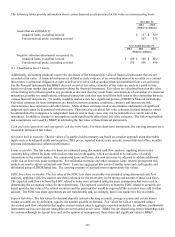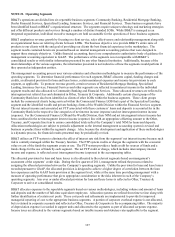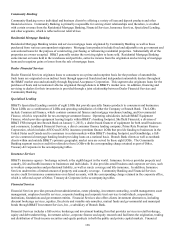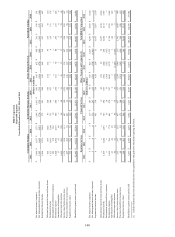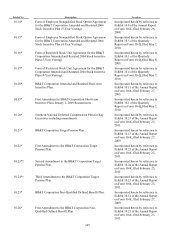BB&T 2012 Annual Report Download - page 157
Download and view the complete annual report
Please find page 157 of the 2012 BB&T annual report below. You can navigate through the pages in the report by either clicking on the pages listed below, or by using the keyword search tool below to find specific information within the annual report.135
Fair Value Hedges
BB&T’ s fixed rate long-term debt, CDs, FHLB advances, loans and state and political subdivision securities produce
exposure to losses in value as interest rates change. The risk management objective for hedging fixed rate assets and
liabilities is to convert the fixed rate paid or received to a floating rate. BB&T accomplishes its risk management objective
by hedging exposure to changes in fair value of fixed rate financial instruments primarily through the use of swaps. For a
qualifying fair value hedge, changes in the value of the derivatives that have been highly effective as hedges are recognized
in current period earnings along with the corresponding changes in the fair value of the designated hedged item attributable to
the risk being hedged.
During the years ended December 31, 2012 and 2011, BB&T terminated certain fair value hedges related to its long-term
debt and municipal securities and received net proceeds of $85 million and $185 million, respectively. When a hedge has
been terminated but the hedged item remains outstanding, the proceeds from the termination of these hedges have been
reflected as part of the carrying value of the underlying debt/other financial instrument and are being amortized to earnings
over its estimated remaining life. The proceeds from these terminations were included in cash flows from financing
activities. During the years ended December 31, 2012 and 2011, BB&T recognized pre-tax benefits of $256 million and
$205 million, respectively, through reductions of interest expense from previously unwound fair value debt hedges.
Derivatives Not Designated As Hedges
Derivatives not designated as hedges are those that are entered into as either balance sheet risk management instruments or to
facilitate client needs. Balance sheet risk management hedges are those hedges that do not qualify to be treated as a cash
flow hedge, a fair value hedge or a foreign currency hedge for accounting purposes, but are necessary to economically
manage the risk associated with an asset or liability.
This category of hedges includes derivatives that hedge mortgage banking operations and MSRs. For mortgage loans
originated for sale, BB&T is exposed to changes in market rates and conditions subsequent to the interest rate lock and
funding date. BB&T’ s risk management strategy related to its interest rate lock commitment derivatives and LHFS includes
using mortgage-based derivatives such as forward commitments and options in order to mitigate market risk. For MSRs,
BB&T uses various derivative instruments to mitigate the income statement effect of changes in the fair value of its MSRs.
For the year ended December 31, 2012, BB&T recorded a gain of $128 million related to these derivatives, which was offset
by a negative $32 million valuation adjustment related to the MSR. For the year ended December 31, 2011, BB&T recorded
a gain of $394 million related to these derivatives, which was offset by a negative $341 million valuation adjustment related
to the MSR.
BB&T also held, as risk management instruments, other derivatives not designated as hedges primarily to facilitate
transactions on behalf of its clients, as well as activities related to balance sheet management.
Derivatives Credit Risk – Dealer Counterparties
Credit risk related to derivatives arises when amounts receivable from a counterparty exceed those payable to the same
counterparty. BB&T addresses the risk of loss by subjecting dealer counterparties to credit reviews and approvals similar to
those used in making loans or other extensions of credit and by requiring collateral. Dealer counterparties operate under
agreements to provide cash and/or liquid collateral when unsecured loss positions exceed negotiated limits.
As of December 31, 2012, BB&T had received cash collateral from dealer counterparties totaling $44 million related to
derivatives in a gain position of $40 million and had posted $639 million in cash collateral to dealer counterparties to secure
derivatives in a loss position of $650 million. In the event that BB&T’ s credit ratings had been downgraded below
investment grade, the amount of collateral posted to these counterparties would have increased by $12 million. As of
December 31, 2011, BB&T had received cash collateral from dealer counterparties totaling $82 million related to derivatives
in a gain position of $79 million and had posted $639 million in cash collateral to dealer counterparties to secure derivatives
in a loss position of $669 million. In the event that BB&T’ s credit ratings had been downgraded below investment grade, the
amount of collateral posted to these counterparties would have increased by $30 million.
After collateral postings are considered, BB&T had no unsecured positions in a gain with dealer counterparties at December
31, 2012, compared to $3 million at December 31, 2011. All of BB&T’ s derivative contracts with dealer counterparties settle
on a monthly, quarterly or semiannual basis, with daily movement of collateral between counterparties required within
established netting agreements. BB&T only transacts with dealer counterparties that are national market makers with strong
credit ratings.








